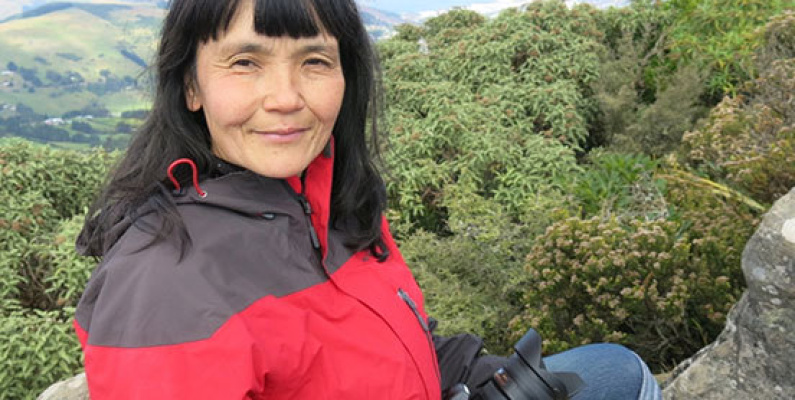
Can you tell us a little about your background – your life in Japan, your professional experience, how and why you came to Dunedin?
I have to confess that originally I wasn’t interested in New Zealand – I knew lots of sheep lived there and that was all – until I saw a photo of a gigantic fluffy bird perfectly blended in the forest and looking straight at the camera. It was a kākāpō. I was shocked by my ignorance, learned that there were only 40 kākāpō left in the world (it was 1990), and became deeply interested in New Zealand wildlife and its conservation efforts.
At that time, I was working with many artists and photographers in an arty publishing company in Tokyo. I was born and bred in downtown Tokyo, studied art philosophy and history in uni, worked as a radio producer, writer, and art exhibition coordinator – very much a city girl. However, after encountering the kākāpō, I quit the company, spent some time in TV nature documentary productions, then came to New Zealand as a working holiday maker to learn more about nature and conservation.
I first came to Dunedin to meet Mr Rod Morris, the best wildlife photographer in New Zealand! I had collected some money to donate to the Department of Conservation's Kākāpō Recovery programme, and he heard about it and kindly offered to show me Dunedin and his workplace, the TVNZ Natural History Unit (now NHNZ). Half a year later, the company hired me for reversioning their famous Wild South series into Japanese. Now, some may say it was coincidence but for me, it was fate. Eventually I got married (to Ulf Schmidt) and we have one daughter.
For the last 25 years, I have been working for TVNZ/NHNZ, NHK (Japanese equivalent of BBC), WWF Japan and other NGOs, newspapers, magazines and websites, and my interests are wildlife, conservation, art and education.
How did you get into photography?
I worked with many photographers as an editor for books/magazines, or TV assistant/coordinator in the field. I learned how to appreciate nature through the lens, and now I am doing it!
You have over 11 000 followers on Instagram. What do you like best about this platform? Do you have any hints for readers on how to get the most out of Instagram?
It’s an easy platform – anyone can post a photo and create a beautiful gallery. That handiness is the key for me to continue, and continuation is the most important thing in achieving anything!
Having said that, I spend a lot of time before posting any photo, and here is what I do. First, choosing a photo. I look at my previous 9 to 12 posts closely; their colour, size, composition, contents, and overall image. Then I choose one photo to add variety and harmony to the gallery. Second, editing the photo. No photographer will publish any photo without editing these days, and I am no exception. Third, research and writing. Sometimes it takes three to four hours, or two to three days, if I cannot find what to say. I often try to read as much as possible about the topic, eg harbour cone or bird’s bill, then write up to a couple of hundred words. I am not at all a perfect nor prolific writer in English, but for Instagram, short captions seem to be welcomed.
As a judge, what will you be looking for in a photo?
Story. Emotion. Vibes.
What websites/blogs/magazines/Instagram accounts do you read/look at for inspiration and ideas?
Dutch artist Stefan’s beautiful Instagram gallery. We made friends through Instagram and sometimes we exchange our deep thoughts on art and life.
The Jane Goodall Institute New Zealand site for inspiration.
The IFLS site to find new ideas and solutions.
What’s your top photography tip for OWPC entrants?
Use continuous mode when taking outdoor photos – even for plants. Wind and light are changing constantly!
You can view Izumi's images on Instagram. And if reading about her life as a photographer has sparked your creative energy, don't forget to enter the Otago Wildlife Photography Competition. Entries close on Friday 1 March 2019.
